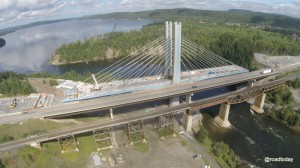
In a teleconference update with industry and media on the ongoing Nipigon River Bridge closure, Ontario Transportation Minister Steven Del Duca says he is confident the bridge will open to two lanes (one each way) by the end of February.
He said experts and engineers will soon decide on one of two options to reconnect the bridge. That construction work will then proceed over the next six weeks or so. During this period, Del Duca warned there will be occasions – mostly during off-peak times and overnight – when the bridge will be fully closed temporarily. He said industry will be notified in advance of full closures and additional restrictions – identifying OTA as a prime source for helping to keep the industry updated.
There is still no alternative road around the bridge other than to enter through the U.S. However, while carriers should plan for the additional restrictions in their operations as they are announced, Del Duca stressed the occasional full closures will not be excessive. He said he expects them to last only between one and two hours at a time.
Currently, alternating eastbound and westbound traffic is moving across a single lane at 25 km/h , with each commercial truck requiring an escort vehicle to cross. Average wait times are about 5 minutes, MTO reports.
In the meantime – thanks to a temporary emergency contingency plan negotiated between OTA and border officials on both sides of the border – carriers also have the option to transport Canadian domestic goods in-transit through the U.S. using a limited data set at select ports of entry. Click here for more details on that option.
Longer term, Del Duca spoke about building-in redundancies for the future. He said negotiations are taking place between government and First Nations communities – perhaps on the issue establishing alternate routes.
He also reported that engineering departments from Western University and National Research Council of Canada have been contracted to find out why the bolts failed and the bridge joint came apart. He said their discoveries will provide “solutions” to ensure the same thing doesn’t happen again.
He also said that all parts of the bridge and cables were manufactured in North America and built to in accordance of all Canadian codes and standards.
[sam id=”9″ codes=”true”]


